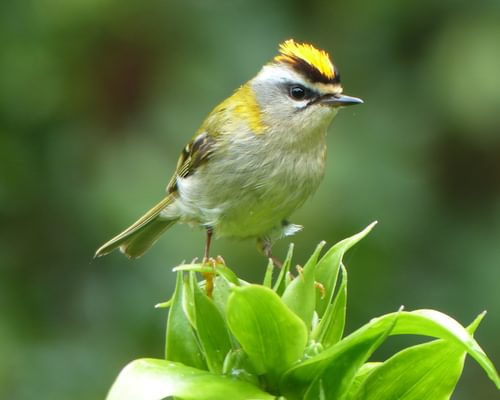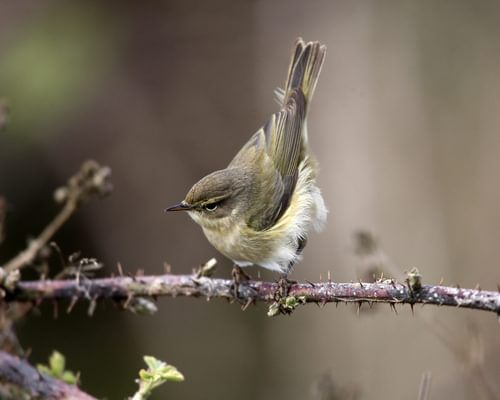Goldcrest
Least ConcernRegulus regulus
Visual Identification
Appearance
The Goldcrest is Europe's smallest bird, with olive-green upperparts and pale underparts. Its most striking feature is a bright yellow crown stripe bordered by black lines. Males have an orange centre in their yellow crest.
Females are slightly duller overall, with a purely yellow crest. Both sexes have a thin, dark bill and pale wing bars.
Juveniles are duller than adult birds with a white eye ring and lack the brightly coloured yellow crown.
Size
Length
8.5cm to 9.5cm
Wingspan
13cm to 15cm
Weight
4.5g to 7g
Habitat and Distribution
Habitats
Woodland
Garden
Wetland
Coastal
Urban
Farmland
Grassland
Desert
Tundra
Rainforest
Mountain
Savanna
Distribution
Goldcrests inhabit coniferous and mixed woodlands across Europe and Asia. They show a strong preference for spruce, fir, and pine forests. In the UK, they are widespread in suitable habitats, including parks and gardens with mature conifers.
During winter, some northern populations move southward or to lower elevations. In harsh weather, they may seek shelter in more diverse habitats, including deciduous woodlands and urban areas.
Elevation Range
Up to 4,000 meters
Climate zones
Temperate, Subarctic
Distribution Map
This map gives you a rough idea of where you might spot a Goldcrest. The coloured areas show countries where these birds have been seen.
A few things to keep in mind:
- Birds might not be everywhere in the coloured areas, for example, they may be present around the coast of that country
- Where birds live can change with seasons and available food
- This map is quite simple - it doesn't show exact locations
We're working on making our maps even better! Soon, we hope to show you:
- More detailed maps for bigger countries, including state and region
- How birds move around during different seasons
Distribution by Region
Behaviour and Ecology
Bird Attributes
This feature is in beta. We'd love your feedback to improve it!
Share your thoughtsBird Attributes Explained
Our bird attributes system rates various aspects of a bird's capabilities on a scale of 0-100, based on data from field observations, scientific studies, and expert knowledge.
Attribute Categories:
- Agility: Manoeuvrability, speed, and grace in flight or movement.
- Strength: Physical power, often correlating with size and hunting abilities.
- Adaptability: Ability to thrive in various environments or changing conditions.
- Aggressiveness: Territorial behaviour and assertiveness, particularly during breeding seasons.
- Endurance: Stamina, often seen in migration patterns or foraging behaviours.
Understanding the Ratings:
- 0-20: Very Low
- 21-40: Low
- 41-60: Average
- 61-80: High
- 81-100: Very High
Remember, these attributes are relative to other bird species and don't necessarily indicate superiority.
Hover over the icon next to each attribute for more information.
Tap the icon next to each attribute for more information.
Agility
Reflects the bird's manoeuvrability, speed, and grace in flight or movement.
The Goldcrest displays remarkable agility, constantly flitting through foliage and often hanging upside down from branches. Their ability to hover whilst gleaning insects from leaves and needles further demonstrates their exceptional manoeuvrability.
Strength
Indicates the bird's physical power, often correlating with size and hunting abilities.
As Europe's smallest bird, the Goldcrest possesses limited physical strength. However, their ability to weave intricate nests and survive harsh conditions suggests they are not entirely without muscular capability, despite their diminutive size.
Adaptability
Represents the bird's ability to thrive in various environments or changing conditions.
Goldcrests show high adaptability, inhabiting various environments from coniferous forests to urban gardens. Their capacity to lower body temperature for energy conservation and undertake perilous sea crossings during migration exemplifies their adaptiveness.
Aggressiveness
Measures the bird's territorial behaviour and assertiveness, particularly during breeding seasons.
Whilst not typically aggressive, Goldcrests display some assertiveness during breeding season, with males showcasing their crown feathers to court females. Their social nature, often forming mixed-species flocks, suggests a generally non-confrontational demeanour.
Endurance
Reflects the bird's stamina, often seen in migration patterns or foraging behaviours.
Despite their tiny size, Goldcrests exhibit impressive endurance. Their ability to survive long migratory journeys across the North Sea and endure harsh winters demonstrates considerable stamina. However, their vulnerability to prolonged severe weather conditions tempers this rating.
Diet
Goldcrests primarily feed on small insects and spiders. They specialise in gleaning tiny prey from the outer branches of trees, particularly conifers.
Their small size allows them to access food sources unavailable to larger birds, and they often hover to pluck insects from needles and leaves.
Behaviour
Goldcrests are remarkably active, constantly flitting through foliage in search of food. They often hang upside down from branches, probing for insects.
These tiny birds are surprisingly social, often forming mixed-species flocks with tits and warblers outside the breeding season.
Vocalisation
The Goldcrest's call is an extremely high-pitched, thin 'see-see-see', often beyond the hearing range of some people. Their song is a series of high, tinkling notes, ending in a flourish, sounding like 'si-si-si-si-si-sisisisisi-see-see-see'. These vocalisations are crucial for locating these tiny birds in dense foliage.
Nesting & Breeding
Breeding occurs from April to July, with pairs forming in early spring. Males court females with vibrant displays of their orange crown feathers. Goldcrests are monogamous during the breeding season.
Nests are intricately woven, deep cups made of moss, lichen, and spider webs, typically suspended high in conifer trees. Females lay 7-12 tiny cream-coloured eggs with fine reddish-brown speckles.
Incubation lasts about 16-17 days, performed solely by the female. Both parents feed the nestlings, which fledge after 17-22 days. Pairs often raise two broods per season.
Lifespan
years
The Goldcrest typically lives for 2 to 3 years.
Like all birds, lifespan can be affected by factors including predation, habitat quality, disease, and access to food sources.
Conservation and Status
Global Conservation Status
While the Goldcrest is currently of Least Concern globally, it is vulnerable to harsh winters and habitat loss. Conservation efforts focus on maintaining diverse forest structures and protecting mature coniferous woodlands, which are crucial for their breeding success.
Birdwatching Tips
- Listen for their high-pitched, thin 'see-see-see' call
- Look for movement in the upper canopy of coniferous trees
- Watch for their characteristic hovering behaviour as they glean insects from foliage
- In the UK, check parks and gardens with mature conifers
Additional Information
Quick Facts
Other names:
Golden-crested Kinglet
Family:
RegulidaePredators
Main predators include small raptors like Sparrowhawks and Merlins, as well as domestic cats in urban areas. Squirrels and corvids may prey on eggs and nestlings.
Did You Know?
- Goldcrests can lower their body temperature at night to conserve energy.
- They are known to cross the North Sea in autumn, sometimes landing on ships for rest.
- A group of Goldcrests is sometimes called a 'crown' or 'realm'.
Was this bird profile helpful?
Your feedback helps us improve our content
Thanks for your feedback!
Your input helps us improve our content.
Community Experience
Community Ratings
2 ratings from birders
Latest Community Reviews
Walt Blake
Stephen jones
Community Reviews
Create Your Free Account Welcome Back!
Join our community to rate birds and share your experiences. Creating an account is completely free and only takes a minute. Sign in to your account to rate birds and share your experiences with our community.
Your information is secure and will never be shared.
By creating an account, you agree to our Privacy Policy.
Similar Birds
References
- 1 2
website: BirdLife International. 2018. Regulus regulus. The IUCN Red List of Threatened Species 2018: e.T22734997A132183740.
View source - 3
report, 2015: EBCC

